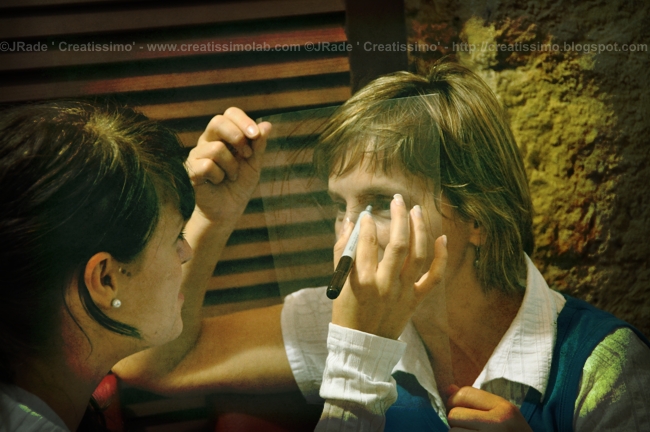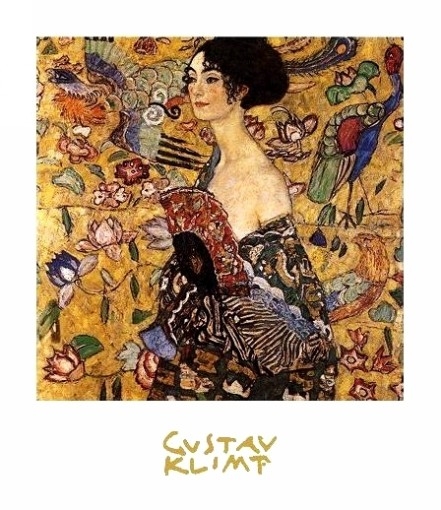…or mind your own business.
First I thought to not write 'provocative' posts anymore like I did with 'I admit'. Because some felt threatened, rather than to feel encouraged to create, which was my intention…
I thought I would shut my mouth and swallow the comments that came to me to my ears, saying that I am jealous of online teachers that I am unable to do something like that myself so I put my frustrations on the others, that I do that to make others miserable etc. And some of the others no longer want to show their works on the Internet because they are afraid of such (unconstructive?) criticism…
However, I've also got some very personal e-mails where people requested and asked for advice and help, so I think the post was worth it, although there were some bad things said about me.
We can look at the things from a wider or narrower point of view. You can see everything or only one thing. You can see the others or only yourself.
In art therapy we look at the situations from several perspectives:
- I (as a therapist in relationship with others)
- I as a client (where I look at the situation from client's perspective)
- I as an external, uninvolved observer (the so-called helicopter perspective).
In such situations, the therapists don't look at the situation from one perspective only, but we need to put ourselves into all. Imagine that we would only look at it from our perspective only! How would we see the World?
Mind your own business. That was a comment that I heard most often after my post 'I admit’. Let them do what they want, create how they want, etc…
Well, let's look at everything from a broader perspective.
Due to the working field that I cover I regularly read professional articles and researches in the field of education, psychology, art therapy, creative process, etc… I recently read some interesting articles that made me think a lot. One was talking about a rape in the middle of the street when the victim, who was calling for help, did not get any help in two hours. Two hours! Mind your own business?!
The second article talked about that it is easier to buy a weapon, rather than get the proper professional help (of psychologist, social worker…) - immediately and now. Mind your own business!
The third article was talking about addiction. What do you do when you meet an addict? Do you mind your own business!?
Why don't my posts on education rise so much noise as it did about creative process and copy-cats in my post ‘I admit’? Or the posts about the victims of crime? Or when I write about how it would be good to help addicts or children, or…? Why no one jumps into the air and write to me and say: mind my own business?
Are addicted happy that we mind our own business? Of course they are, as no one disturbs them, so they may continue to sink deeper and deeper into addiction. But do we want that? Do we really not care? And then these addicts, because of their need for drugs, will attack a person with a broken bottle and cut a person just to steal/get money for drugs!
Now transfer this thinking to the field of creativity. Is this field really different from other fields?
The easiest way is to say mind your own business. The easiest way is to shout: who do you think you are!
When you talk to a person who is trimmed, bruised, raped, and with damaged head because of the brutal rape (I did), you learn that no one ever deserves to hear words like: who do you think you are. When you see the sexually abused child, you don't dare to say mind your own business… We are all humans, we are the World, we all live together. And this is important in every area/field of our lives.
Therefore, look at the creating from a broader perspective. I am willing to help the others with my creative knowledge (the one I have). But I can also say I don't care… I can need help or advice or criticism, but can also close myself and tell the others: mind your own business (I think 'mind your own business' is a very popular sentence in this era, and competing too).
So I'll ask two questions to give you something to think about:
a)
You managed to create the best art work ever. You are extremely proud of it, and soooo happy. Then after a week, you find out that someone has painted a nearly identical piece of art. It turns out that your work was his inspiration and that he painted the image, as precisely as he could to make a copy of your art work. How do you feel? Oh, great, you say, because you find it flattering that someone has painted one of your creations. Ok, really, he did make a copy of your work, but he chose your art work, so you feel great because you have become important and you are an example to someone (or a teacher or a muse)… Well, over a time your work is copied 10, 20, 30 times… Is that still a pleasure for you? Are you feeling important, a star? I doubt it. Would you like that your art work inspires the others, but not like that: that people make copies of your art works?... When it will happen to you, you will understand what I'm trying to say in my post 'I admit'. I do understand the difference between learning the technique and copying. And my purpose and hope is that no one is caught in the circle of copying, which has nothing to do with creating. But I will not point my finger at you and say 'see, I told you!' if this happens to you. We carry our consequences alone, and therefore there's no need to say it out loud (Montessori pedagogic calls that: control points).
Do the addicts know that they fell into the circle of addiction? Do they admit they’re addicted? Do those who copy know that they fell into a circle of copying? Do they recognize it that copying is wrong? What if they manage to sell a thousand copies of ‘your’ art work, and you can't? What if people start to say that you copied his works?...
The answer of one of the persons who copies, was: but I didn't copy a photograph of the art work (copy-paste), I made it myself and put it on my 'blog' (identical to the original art work of another author). Until you will experience this with your own art works, until you will put yourself in the shoes of the author of original, you probably will not understand what I mean…
Some have even snapped at my education. As the art teacher I therefore have no rights 'to be smart'? What is your profession? What if I say something not nice about your expertise, your profession? I don’t claim to be an artist. You see: I am not a painter, I am not a sculptor, I'm not graphic designer, but I am art teacher. I am a person who helps the others to create, which is not the same as if I create art works myself. For many academic painters, sculptors... it was known that they were lousy teachers and vice versa. I am not an artist, but I am art teacher and art therapist, with experiences. I'm not ashamed to say it out loud. And I do know I'm not the best, I am not the one and only. I know where my limits are and I know that I will learn to be better and to create all my life.

(Creatissimo Art therapy Workshop)
b)
What do you do when you see someone who is trapped and makes the same mistake over and over again? Whenever he takes a glass in his hands, the glass falls to the floor. Whenever he writes, he forgets to put a question mark at the end of the question. Always, when you are at the dentist, the dentist forgets a tampon in your mouth. What do you do? Are you quiet? Do you make fun of his awkwardness? Are you angry, because he makes the same mistakes a thousand times and doesn't learn from them?
And what would you do if you see that someone has the same problems over and over again as he creates? He always gets stuck in the same place, always ruins his art work with the same 'mistake'... What would you do?
In art therapy, we have a principle that the client should see (and test) a sample(s) of behavior 'patterns', with which he would be able to replace the old (bad) behavior pattern. How about in creating? Which ‘bad’ pattern prevents you from going through?
Art Education is, therefore, not there to teach you to draw perfect eyes, fantastic realistic drawings, etc… As I wrote then, realism and abstraction have nothing to do with my point about which I talked about in ‘I admit’. Art Education (or any other good teacher or mentor or…) serves as a support and a place to show you the patterns from which you choose one that suits you to go your own way… Your way!
When I was abroad I had no problem with ‘criticism’ like I see it here, in my country. Wherever I went (U.S.A, Denmark, the Netherlands, Austria, Italy, Bosnia…), people were open and wanted to know more. Therefore I ask you, what would you say if I was from abroad and would be a participant of an Internet e-course? Would you accept my ‘critique’? And how would you accept my criticism, knowing that I am an art teacher from Slovenia? I noticed the difference. I see that we are open to persons who are ‘at a safe distance’, so that we do not feel any competition and a threat. But when there are people from our country, everything is different. Hiding information, no comments to help somebody to move forward, lack of confidence… I’m sorry but that’s how I see it. I wish we would see that life is too short to not live it fully.
There is a support and a technical support. We need both. We all need support, and I am sorry that some focus all of their energy into defense, rather than focusing their energy for exceeding the limits.
I give you the opportunity to tell me that I am wrong. Here, now, 'face to face'. To prove to me that there is a different point of view. I will not argue about it. I will try it and determine whether this pattern will work for me. I want to believe that I’m wrong.
I see the World as a beautiful place. Because I believe in the collective consciousness and because I believe we should be positive, creative, energetic, I don’t mind my own business only. I care! I am nothing and nobody if I don’t care, if there’s no 'you' near me...
*
Thanks for the lovely birthday wishes and words of support. I saved them in my heart and I carry them with me all the time as precious diamonds now. :)
And I have another happy news to tell: I received a confirmation from Finland that I’ll have two great mentors for my phototherapy project. You bet I jumped up high from happiness again! :)





